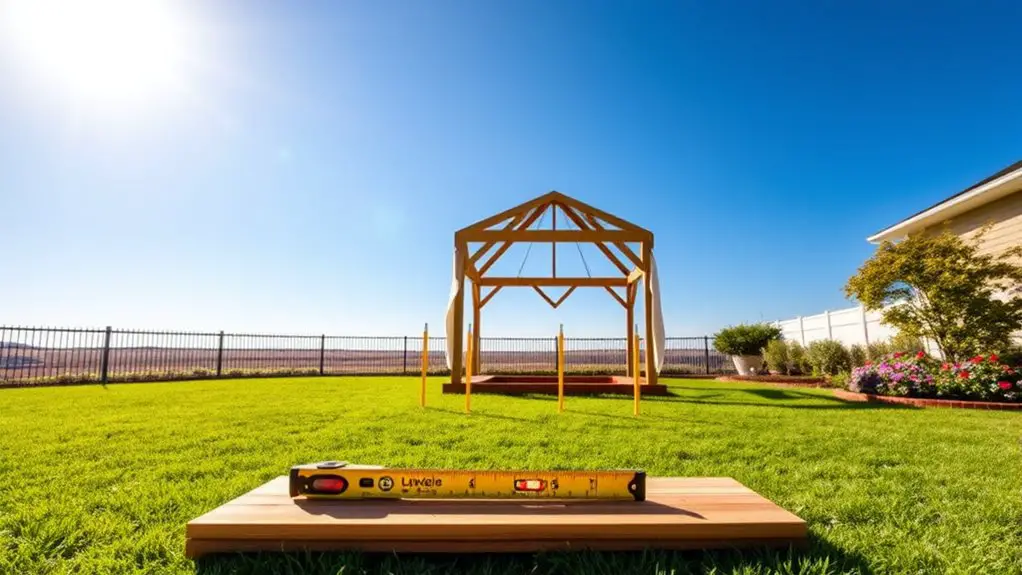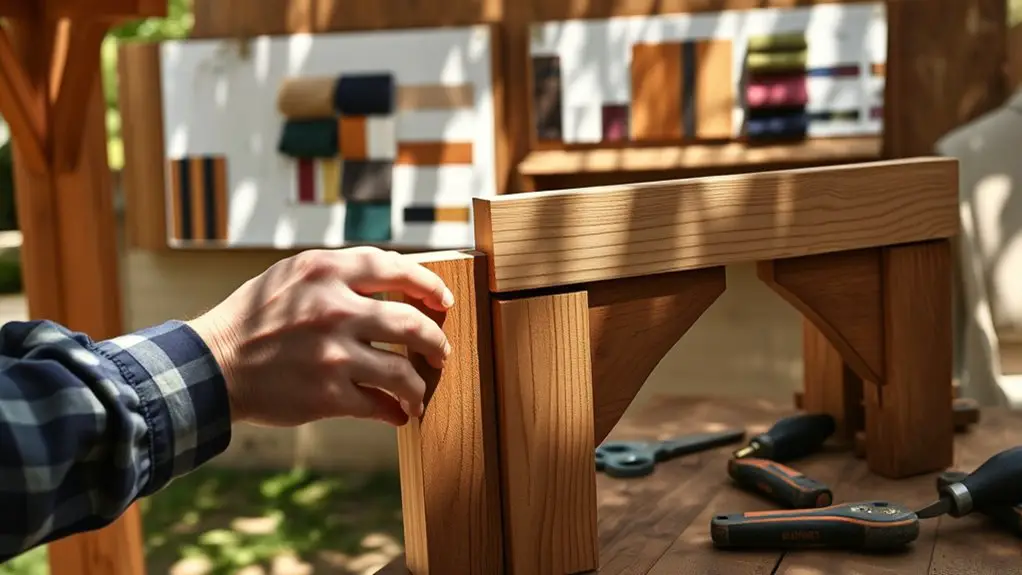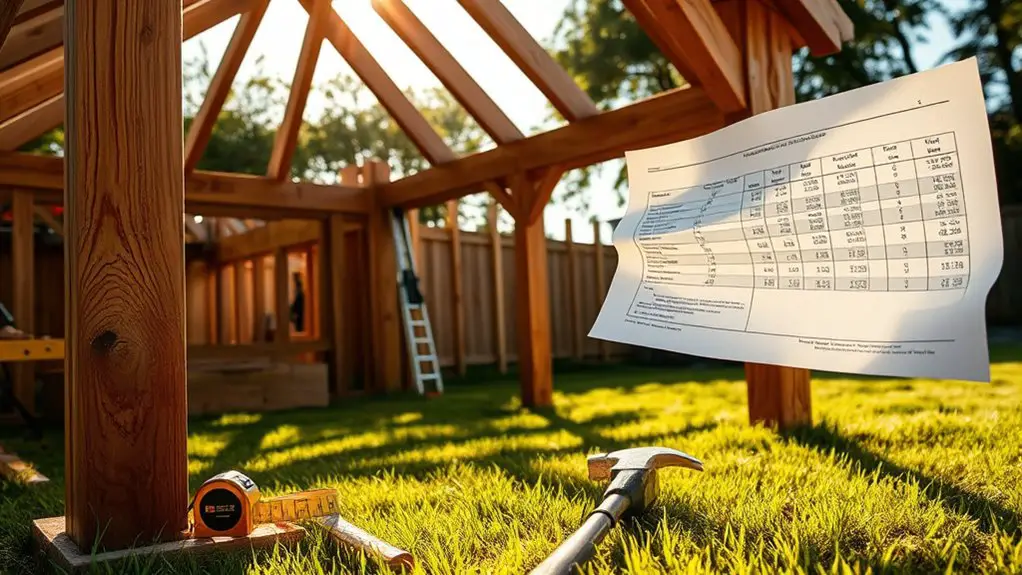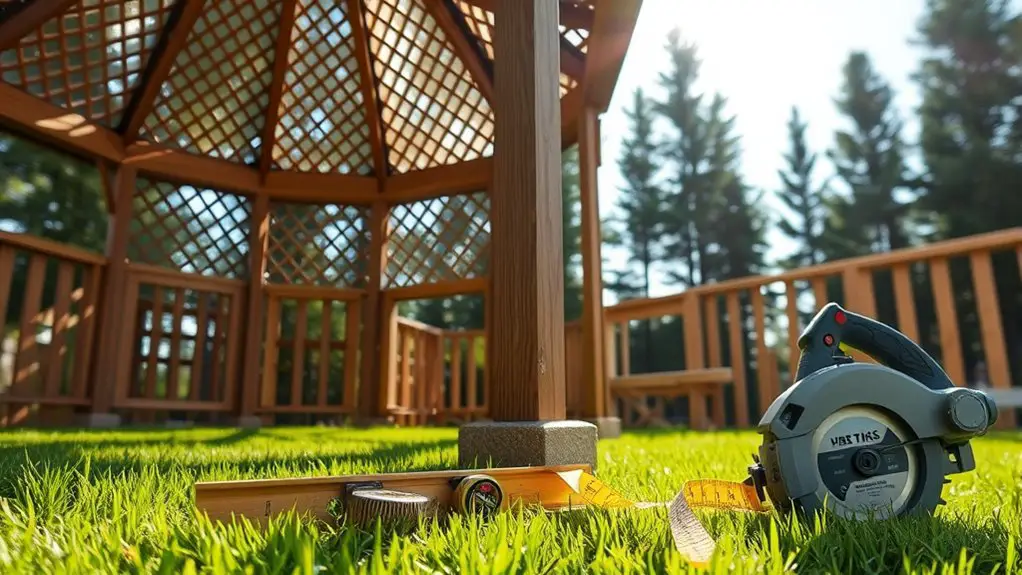When constructing a gazebo, start by choosing the right location, guaranteeing ideal sunlight and level ground. Select durable materials like pressure-treated lumber or aluminum, while considering your design style—be it traditional, modern, or rustic. Keep your budget in mind; accurately estimate material and labor costs. Gather essential tools, follow safety guidelines, and establish a maintenance routine to guarantee longevity. There’s much more to explore about perfecting your gazebo project, so keep going for additional insights.
Choosing the Right Location

When selecting the right location for your gazebo, it’s vital to contemplate not only aesthetics but also functionality. First, consider sunlight exposure; too much direct sunlight can make your gazebo uncomfortable, while too little may limit its usability. Position it where you can enjoy warm rays during cooler months, yet find shade during the heat of summer.
Next, evaluate nearby structures. Trees can provide natural shade but may also drop leaves and debris, requiring additional maintenance. Buildings or fences might create unwanted shadows or obstruct views, so think carefully about proximity. You’ll want a location that balances privacy with openness, allowing you to feel free while still enjoying your surroundings.
Lastly, verify the ground is level and stable. This foundation is essential for a secure build. By thoughtfully addressing these factors, you’ll create a space that enhances your outdoor experience, marrying style with purpose. Additionally, consider the orientation of the backyard to maximize sun exposure and wind protection throughout the day.
Selecting Appropriate Materials
While you might be tempted to choose the most visually appealing materials for your gazebo, it’s crucial to take into account durability and maintenance as well. When considering wood selection, opt for pressure-treated lumber or cedar, known for their longevity and resistance to decay. If you’re leaning towards metal options, aluminum and galvanized steel can provide a modern touch while ensuring sturdiness against the elements. Additionally, consider using polycarbonate roofing for its lightweight and UV-resistant properties.
Here’s a quick comparison to guide your decision:
| Material Type | Pros | Cons |
|---|---|---|
| Wood | Natural aesthetic, versatile | Requires regular maintenance |
| Aluminum | Lightweight, rust-resistant | Can get hot in sunlight |
| Steel | Very durable, strong | Heavier, may rust without coating |
Choosing the right materials can transform your gazebo into a lasting haven, allowing you to enjoy your outdoor space without constant worry.
Understanding Design Styles

When it comes to designing your gazebo, understanding the various styles can greatly influence both aesthetics and functionality. You’ll want to reflect on popular designs, the materials that complement them, and how they fit into your overall landscape. Each choice impacts not just the look, but also how you’ll use the space, so let’s explore these elements together. Additionally, considering the different types of gazebos can help you select the perfect structure that suits your needs and enhances your outdoor environment.
Popular Gazebo Styles
As you explore the world of gazebo construction, understanding the various design styles can greatly enhance your project’s appeal and functionality. You’ll find that choosing between traditional designs and modern aesthetics can set the tone for your outdoor space. Here’s a quick comparison to guide your decision:
| Style | Features |
|---|---|
| Traditional | Classic shapes, ornate details |
| Modern | Sleek lines, minimalist approach |
| Rustic | Natural materials, cozy feel |
Consider how each style complements your home and backyard. Traditional designs often evoke nostalgia, while modern aesthetics offer a fresh, clean look. Ultimately, your choice should reflect your personal taste and how you envision using the gazebo.
Materials and Aesthetics
Choosing the right materials for your gazebo not only impacts its durability but also greatly influences its overall aesthetic. When you explore material textures, consider how wood, metal, or composite elements can create different vibes. For instance, natural wood offers warmth, while sleek metal can evoke a modern feel. Pairing these materials with the right color palettes enhances your gazebo’s visual appeal. Earthy tones can promote a rustic charm, while bold hues can make a statement. Think about how these choices reflect your personal style and the surrounding environment. Ultimately, the harmony of textures and colors will shape the essence of your gazebo, allowing it to become a seamless extension of your outdoor space, fulfilling your vision of freedom and relaxation.
Functional Design Considerations
While you may envision your gazebo as a serene retreat, its design must also serve practical purposes. Balancing functionality features with aesthetic appeal is essential. Think about how you’ll use the space—will it be for gatherings, relaxation, or both?
Here’s a simple table to help visualize some key design elements:
| Functionality | Design Element | Purpose |
|---|---|---|
| Seating | Built-in benches | Comfortable relaxation |
| Lighting | Overhead fixtures | Ambiance for evenings |
| Privacy | Lattice or curtains | Shield from prying eyes |
Planning Your Budget

When planning your gazebo budget, it’s essential to accurately estimate material costs, as these will form the bulk of your expenses. Don’t forget to factor in labor costs, whether you’re hiring professionals or enlisting friends for a DIY project. A well-structured budget will help you avoid unexpected financial strains and keep your vision on track. Additionally, consider how factors like size and material choice can significantly influence your overall costs.
Estimate Material Costs
To guarantee your gazebo project stays within budget, it’s essential to accurately estimate material costs before you begin construction. Start by researching current prices for timber, roofing, and other materials, keeping in mind that material price fluctuations can impact your overall budget. Consider the quantity you’ll need; sometimes, buying in bulk can lead to significant savings through bulk purchasing discounts. It’s wise to create a detailed list of required materials, including dimensions and types, to make sure you’re not underestimating costs. By planning ahead, you’ll not only maintain financial freedom but also avoid the stress of unexpected expenses. This way, you can focus on building your dream gazebo without financial constraints holding you back.
Factor in Labor Expenses
As you plan your budget for the gazebo construction, it’s essential to factor in labor expenses, since these costs can greatly impact your overall financial plan. Labor costs can vary considerably based on the complexity of your project and the expertise required. If you’re considering hiring professionals, it’s wise to get multiple quotes to guarantee you’re getting a fair rate. Evaluate the skill level needed—complex designs might require skilled carpenters, while simpler builds could be manageable with less experience. By understanding the labor market in your area, you can make informed decisions that align with your budget and vision. Ultimately, investing in quality labor can enhance your gazebo’s durability and aesthetics, granting you the freedom to enjoy your creation for years to come.
Gathering Essential Tools
Before you immerse yourself in your gazebo project, gathering essential tools is crucial for a smooth construction process. Start by identifying the tool types you’ll need: measuring tape, level, saw, hammer, and drill are fundamental. If you’re considering a more intricate design, a miter saw and nail gun might be advantageous.
Don’t overlook the importance of tool maintenance; having your equipment in prime condition saves you time and frustration. Regularly check your tools for wear and tear, and confirm they’re clean and properly lubricated. This not only enhances performance but also extends their lifespan, allowing you to focus on building rather than constant repairs.
Lastly, consider your workspace. A well-organized area with easy access to your tools will empower your creativity and freedom during the construction process. Equip yourself wisely, and you’ll set the stage for a successful gazebo project that reflects your personal vision. Additionally, ensure you have a plan for proper anchoring to maintain stability and safety during inclement weather.
Following Safety Guidelines
While constructing your gazebo can be an exciting endeavor, prioritizing safety guidelines is essential to prevent accidents and guarantee a smooth workflow. Start by equipping yourself with the necessary safety gear, including gloves, goggles, and a hard hat. These items protect you from flying debris and sharp tools, ensuring you can work freely without the worry of injury.
Next, develop a strong sense of hazard awareness. Identify potential risks in your workspace, such as uneven ground or sharp edges, and take proactive measures to mitigate them. Keep your work area tidy, as clutter can lead to trips and falls. When using power tools, always follow the manufacturer’s instructions and never operate them under the influence of fatigue or distraction. Additionally, regularly inspect structural integrity to ensure your gazebo remains safe throughout its use.
Maintenance Tips for Longevity
To guarantee your gazebo stands the test of time, regular maintenance is key. Start with routine inspections, checking for signs of wear, rot, or insect damage. Catching issues early can save you from costly repairs down the road. Pay special attention to joints and connections, as they often bear the brunt of stress.
Seasonal upkeep is equally vital. In spring, clean the wood and apply protective sealant to prevent moisture damage. In the fall, clear away leaves and debris that could trap moisture. If you live in a snowy area, gently remove accumulated snow to prevent collapse. Additionally, ensure you check for water damage during inspections to address any leaks or rot promptly.
Lastly, consider applying a fresh coat of paint or stain every few years to enhance aesthetics and protection. By committing to these practices, you’ll not only extend your gazebo’s life but also guarantee it remains a cherished retreat for years to come.
Frequently Asked Questions
How Long Does It Typically Take to Build a Gazebo?
Building a gazebo typically takes one to three weekends, depending on your construction timeline and the gazebo materials you choose. Proper planning can free up time, ensuring your project progresses smoothly and efficiently.
Do I Need a Permit for Gazebo Construction?
Before beginning, check local building codes and permit requirements. You can’t cut corners here! Compliance guarantees construction clarity and community cooperation, so you’re free to enjoy your gazebo without future hassles or headaches.
Can I Build a Gazebo on Uneven Ground?
You can build a gazebo on uneven ground by using leveling techniques and exploring various foundation options. Proper adjustments guarantee stability, allowing you to create your ideal outdoor space without compromising design or functionality.
What Are Common Mistakes to Avoid When Building a Gazebo?
When building a gazebo, you should avoid design flaws and improper material selection. Guarantee your plans are precise, materials are durable, and always double-check measurements. A solid foundation leads to lasting freedom in your outdoor space.
How Do I Insulate My Gazebo for Year-Round Use?
Imagine sipping coffee in winter’s embrace; to achieve that, choose insulation materials like foam boards or fiberglass. Pair them with efficient heating options like electric heaters, and your gazebo transforms into a cozy year-round retreat.

